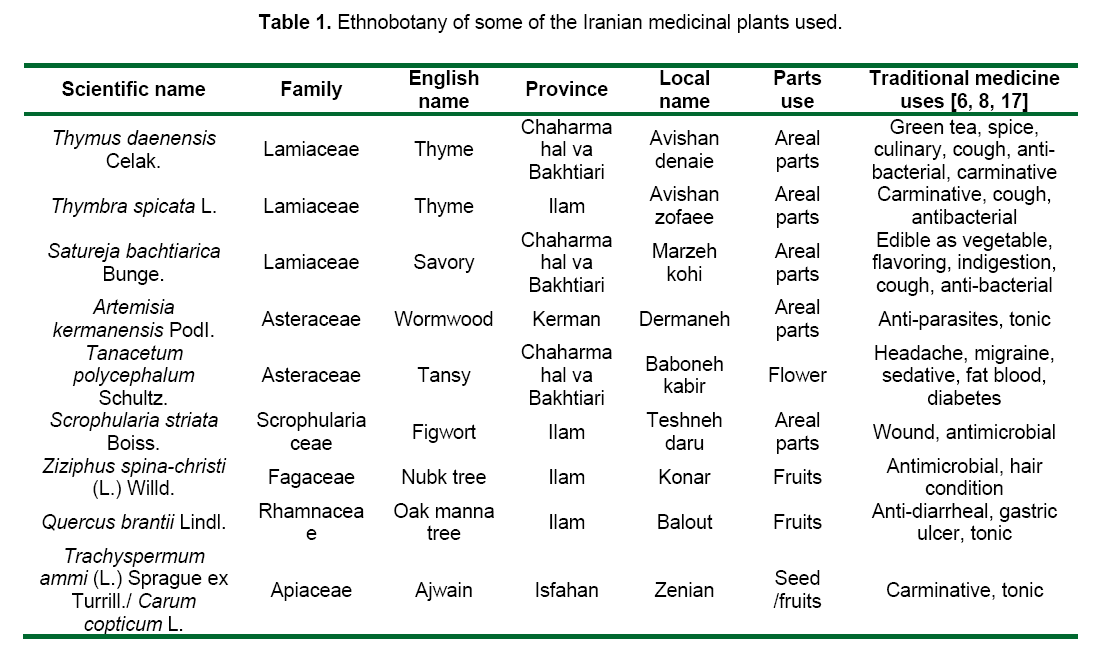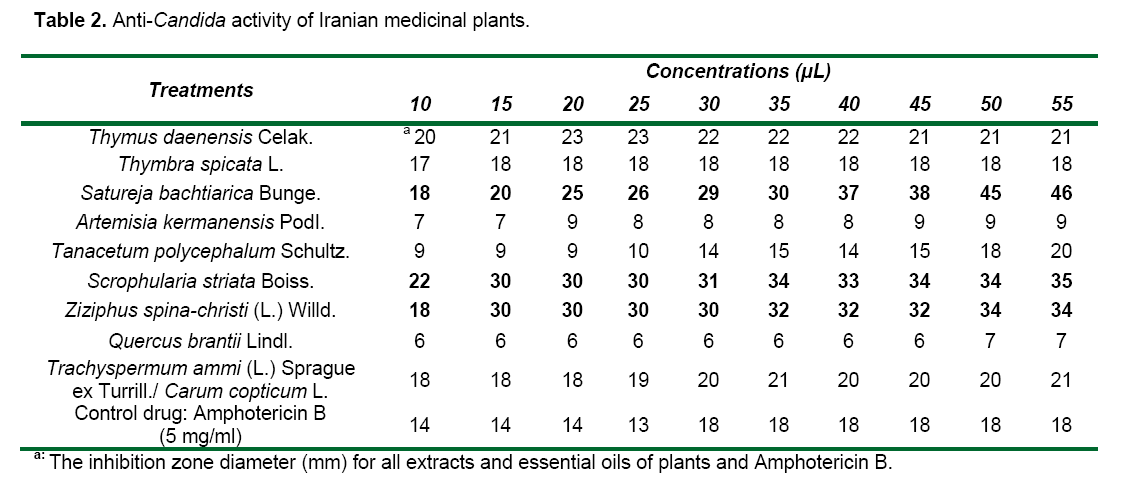Anti-Candida Activity of Some of the Iranian Medicinal Plants
Abdollah Ghasemi Pirbalouti, Mahmood Bahmani, Majid Avijgan
Abdollah Ghasemi Pirbalouti1*,Mahmood Bahmani1,Majid Avijgan2
1Researches Centre of Medicinal Plants & Ethnoveterinary,Islamic Azad University of Shahrekord Branch,Shahrekord,Iran
2Researches Centre of Iranian Traditional Medicine,Medical University of Isfahan,Isfahan,Iran.
- Corresponding Author:
- Abdollah Ghasemi Pirbalouti
Tel: +98 (0)381-3361070
Fax: +98(0)381-3361060
E-mail: ghasemi955@yahoo.com
Abstract
In this study, anti-Candida activities of extract and essential oil of nine Iranian folklore plants including, Satureja bachtiarica Bunge., Thymus daenensis Celak., Scrophularia striata Boiss., Thymbra spicata L., Tanacetum polycephalum Schultz., Artemisia kermanensis PodI., Ziziphus spina-christi (L.) Willd., Trachyspermum ammi (L.) Sprague ex Turrill./ Carum copticum L. and Quercus brantii Lindl. were investigated against of Candida albicans by agar disc diffusion assay. The results showed that essential oils from five herbs showed anti-Candida activity, including Satureja bachtiarica, Thymus daenensis, Thymbra spicata, Tanacetum polycephalum and Trachyspermum ammi. Also, the extracts of Scrophularia striata and Ziziphus spina-christi were the most active effective at any of the concentrations tested. The essential oil and extract of Artemisia kermanensis and Quercus brantii were not effective at any of the concentrations tested. In conclusion it can be said that the extract and essential oil of some of the Iranian medicinal plants could be used as natural anti-Candida.
Keywords
Candida albicans; medicinal plants; antifungal activity.
1. Introduction
The extracts and essential oils of many plants/ herbs have been shown to exert biological activity in vitro and in vivo,which justified research on traditional medicine focused on the characterization of antimicrobial activity of these plants. Iran,India,Pakistan,Turkey,Jordan,Brazil and Mexico are examples of countries that have a diverse flora and a rich tradition in the use of medicinal plants for both antibacterial and antifungal applications [11,12].
Since plants produce a variety of compounds with antimicrobial properties,it is expected that screening programs for some under-represented targets,such as antifungal activity,may yield candidate compounds for developing new antimicrobial drugs [1]. In addition,it is expected that plant compounds showing target sites other than those currently used by antibiotics will be active against drug-resistant microbial pathogens [3].
Candidiasis caused by Candida has increased substantially in the past 20 years. Candida is capable of causing a variety of superficial and deepseated mycoses. Candida species are now recognized as major agents of hospital acquired infection. Candida albicans the most causative agent,accounting for more than 90% of cases [4]. However,other Candida species such as C. glabrata,C. parapsilosis,C. tropicalis,and C. krusei may also cause symptomatic oral candidiasis in HIV-positive individuals [10].
In this study,ethnomedicine and ethnobotanical information which is one of the tools,which can be employed in choosing candidate plants for study,was used in Shahrekord,Ilam,Isfahan and Kerman regions,in Iran to identify plants that are used for treatment of Candida infections including vaginal candidiasis. This previous knowledge was instrumental in identifying some of the plants that are reported in this study.
No systematic studies have yet been carried out on the evaluation of anti-Candida activities some of the Iranian folklore plants (for example: Thymus daenensis,Satureja bachtiarica,Scrophularia striata,Thymbra spicata and Tanacetum polycephalum).
2. Materials and Methods
Plant material
A list of the plants studied,including the botanical name and data related to traditional use and plant parts used,are listed in Table 1. The plants were collected from mountain areas of Zagross,Chaharmahal va Bakhtiari,Isfahan,Kerman and Ilam Provinces,Iran,during May–Nov,2007. Their identity was confirmed and voucher specimens were deposited at the Researches Centre of Medicinal Plants & Ethno-veterinary,Islamic Azad University of Shahrekord Branch,Shahrekord,Iran.

Essential oil and extract preparation
Plant material (leaves,flowers,seeds and fruits) were dried at 50 °C in the shade at room temperature before grinding to fine powders using a mixer (Molinex ®). The essential oils of Satureja bachtiarica,Thymus daenensis,Thymbra spicata,Tanacetum polycephalum and Artemisia kermanensis leaves and Trachyspermum ammi fruits were obtained from hydro-distillation (2000 ml distillate water) for 2 h using a Clevenger-type apparatus according to the method recommended in British pharmacopoeia [2].
The extracts of Scrophularia striata leaves and stem,Zizyphus spina-christi fruits and Quercus brantii fruits were refluxed with 500 mL of double distilled water for 2 h at 70 °C. The infusions were filtered and concentrated under rotary vacuum (model Zirbus 302®) for about 1 h. Oil and extracts samples were stored at 5 °C in sealed glass vials.
Fungi
The activity of essential oils and extracts were assayed against isolate of Candida albicans. A clinical strain of Candida albicans isolated from vaginal of patients at the woman clinical,Hajar Hospital and identified in the Mycology Department,Medical University of Shahrekord,Iran. The Candida grown overnight at 36 °C in RPMI 1640 with 1-gluamin without bicarbonate sodium with MOPS (0.165 μ,pH=7.5) plates,and inoculums for the assays was prepared by diluting scraped cell mass in solution,adjusted to McFarland scale 0.5 and confirmed by spectrophotometer reading at 600 nm. Cell suspensions were finally diluted to 106 colony forming units (CFU)/ml for use in the assays.
Agar diffusion assay
The antimicrobial activity was carried out by using the disc diffusion method. Sabouraud dextrose agar (SDB) (Merck,Germany) was used to prepare the culture medium and autoclaved at 121 °C for 15 min. In sabouraud dextrose agar plates 20 μL of fungi (final concentration) were spread and 10,15,20,25,30,35,40,45,50,55 μL of each total extracts and essential oils were applied in to the plate surfaces.The extracts were dissolved in dimethyl sulfoxid (DMSO,10 μL) before the test for antimicrobial activity. Plates were then incubated at 37 °C for 48 h. Amphotericin B (5 mg/ml) was dissolved in DMSO and served as positive control. Microbial growth inhibition was determined as the diameter of the inhibition zones around the discs (mm). The growth inhibition diameter was an average of three measurements,taken at three different directions. All tests were performed in triplicate.
3. Results
The growth inhibition value of extract and essential oil on Candida albicans are shown in Table 2. The extracts from different plant species studied showed antifungal activities,with the diameters of inhibition zone ranging from 7 to 46 mm. There were significant differences (P ≤ 0.05) in the antifungal activities of plant extracts. As shown in Table 2,extracts of Scrophularia striata and Ziziphus spinachristi and essential oils of Satureja bachtiarica,Thymus daenensis,Thymbra spicata,Tanacetum polycephalum and Trachyspermum ammi showed antifungal activity against Candida albicans. Among the plants tested essential oil of Satureja bachtiarica and extracts of Scrophularia striata and Ziziphus spina-christi showed the best anti-Candida activity. Followed,the essential oils of Thymus daenensis,and Trachyspermum ammi and Amphotericin B showed strong inhibitory (Table 2). The result showed that most of the extract and essential oil could effectively inhibit the growth of Candida albicans. The most active of the concentration was high concentrations (50-55 μL) inhibiting the growth of yeast (Table 2).

4. Discussions and Conclusions
The strongest activity was shown by essential oil of Satureja bachtiarica and extracts of Scrophularia striata and Ziziphus spina-christi against Candida albicans. This study,high concentrations (50-55 μL) of extracts and essential oil were significantly more active against yeast. Good activity was observed also in the essential oil of Satureja bachtiarica,which inhibited microbial with the diameters of inhibition zone ranging from 18 to 46 mm. Other the essential oils showed only slight inhibition of tested microorganisms. Some studies claim that the phenolic compounds present in spices and herbs might also play a major role in their antimicrobial effects [9]. There has been no large scale systematic investigation of the relationship between bacterial inhibition and total phenolic content of spices and herbs. Previous studies [15] showed that a highly positive linear relationship exists between antioxidant activity and total phenolic content in some spices and herbs.
Many herb and spice extracts for example Satureja bachtiarica contained high levels of phenolics and exhibited antimicrobial activity. The result of a study [14] showed that the essential oil of Satureja bachtiarica contained thymol (44.5%) and γ-terpinene (23.9 %). Sonboli et al.,2004 reported that essential oil of Satureja laxiflora exhibited antimicrobial activities against Candida albicans ATCC 5027,Aspergillus niger ATCC 16404,Saccharomyces cerevisiae ATCC 9763,Klebsiella pneumoniae ATCC 3583 and Enterococcus faecalis ATCC 15753. Chemical studies confirmed that a major portion of this antimicrobial activity is due to thymol (64%) present in the oil [16]. Previous studies [13] on the antimicrobial activity of the essential oils of some Thymus spp.,most of them possessing large quantities of phenolic monoterpenes,have shown activity against viruses,bacteria,food-derived microbial strains and fungi.
Pervious works [7] showed that essential oils of Thymus daenensis and Thymbra spicata leaves and flowers exhibited antibacterial activities against L. monocytogenes from chicken meat. Fazeli et al.,2007 studied antimicrobial effects of two medicinal plants (Rhus coriaria L. and Zataria multiflora Boiss.) used in Iranian traditional medicine were investigated against some pathogenic food-borne bacteria. The minimum inhibitory concentrations of Rhus coriaria and Zataria multiflora were determined against several strains of Gram-positive and Gram-negative bacteria [5]. The essential oil and extract of some aromatic plants (for example mint family,Lamiaceae) with a higher percentage of cavracrol and thymol have a higher efficacy against microbial [13].
These results corroborate the importance of ethno-pharmacological surveys in the selection of plants for bioactivity screening. The results obtained represent a worthwhile expressive contribution to the characterization of the anti-Candida activity of essential oils and plant extracts of traditional medicinal plants from the Iranian flora. Subsequently,bio-guided fractionation will be conducted on plants showing potential anti-Candida activity to identify the active compounds. Evaluations of the essential oils against other important human pathogens are also being conducted.
Acknowledgements
This work was supported by Islamic Azad University,Shahrekord (Researches Affairs).
References
- Ahmad I.,Beg A.Z. (2001). Antimicrobial and phytochemical studies on 45 Indian medicinal plants against multi-drug resistant human pathogens. Journal of Ethnopharmacology,74: 113–123.
- British Pharmacopoeia. (1988). (Vol. 2,pp. 137–138). London: HMSO.
- Duarte M.C.T.,Figueira G.M.,Sartoratto A.,Rehder V.L.G.,Delarmelina C. (2005). Anti-Candida activity of Brazilian medicinal plants. Journal of Ethnopharmacology,97: 305–311.
- Edwards J.E. (1995). Candida species. In: Mandell G.L.,Bennett J.E.,Dolin R. editor. Mandell,Douglas and Bennett's principles and practice of infectious diseases. 4. Vol. 2. New York: Churchill Livingstone; pp. 2289–2301.
- Fazeli M.R.,Amin,GH.R.,Ahmadian Attari,M.M.,Ashtiani,H.,Jamalifar.,H.,& Samadi,N. (2007). Antimicrobial activities of Iranian sumac and avishan-e shirazi (Zataria multiflora) against some food-borne bacteria. Food Control,18: 646–649.
- Ghasemi Pirbalouti A. (2009). Medicinal plants used in Chaharmahal and Bakhtyari districts,Iran. Herba Polonica,55: 69-77.
- Ghasemi Pirbalouti A.,Roshan Chaleshtori A.,Tajbakhsh E.,Momtaz H.,Rahimi E.,Shahin F. (2009). Bioactivity of medicinal plants extracts against Listeria monocytogenes isolated from food. Journal of Food Agriculture & Environment,7: 132-135.
- Ghorbani A. (2003). Studies on pharmaceutical ethnobotany in the region of Turkmen Sahra,north of Iran. Journal of Ethnopharmacology,102: 58-68.
- Hara-Kudo Y.,Kobayashi A.,Sugita-Konishi Y.,Kondo K. (2004). Antibacterial activity of plants used in cooking for aroma and taste. Journal of Food Protection,67: 2820–2824.
- Krcmery V.,Barnes A.J. (2002). Non-albicans Candida species causing fungaemia: Pathogenicity and antifungal resistance. Journal of Hospital Infection,50: 243–60.
- Mahasneh A.M.A.,Adel M.A.,El-Oqlah A.A.B. (1999). Antimicrobial activity of extracts of herbal plants used in the traditional medicine of Jordan. Journal of Ethnopharmacology,64: 271–276.
- Navarro V.,Villarreal M.L.,Rojas G.,Lozoya X. (1996). Antimicrobial evaluation of some plants used in Mexican traditional medicine for the treatment of infectious diseases. Journal of Ethnopharmacology,53: 143–147.
- Rasooli I.,Rezaei M. B. Allameh A. (2006). Ultrastructural studies on antimicrobial efficacy of thyme essential oils on Listeria monocytogenes. International Journal of Infection Diseases,10: 236- 241.
- Sefidkon F.,Jamzad Z. (2000),Essential oil of Satureja bachtiarica Bunge. Journal of Essential Oil Research,12: 545-546.
- Shan B.,Cai Y.Z.,Sun M.,Corke H. (2005). Antioxidant capacity of 26 spice extracts and characterization of their phenolic constituents. Journal of Agricultural and Food Chemistry,53: 7749–7759.
- Sonbolia A.,Fakharib A.R.,Kanania M.R.,Yousefzadic M. (2004). Antimicrobial activity,essential oil composition and micromorphology of trichomes of Satureja laxiflora C. Koch from Iran. Z. Naturforsch,59: 777-781.
- Zargari A. Medicinal Plants. University Publication,Tehran. 1989–1992 (in Persian).

Open Access Journals
- Aquaculture & Veterinary Science
- Chemistry & Chemical Sciences
- Clinical Sciences
- Engineering
- General Science
- Genetics & Molecular Biology
- Health Care & Nursing
- Immunology & Microbiology
- Materials Science
- Mathematics & Physics
- Medical Sciences
- Neurology & Psychiatry
- Oncology & Cancer Science
- Pharmaceutical Sciences
